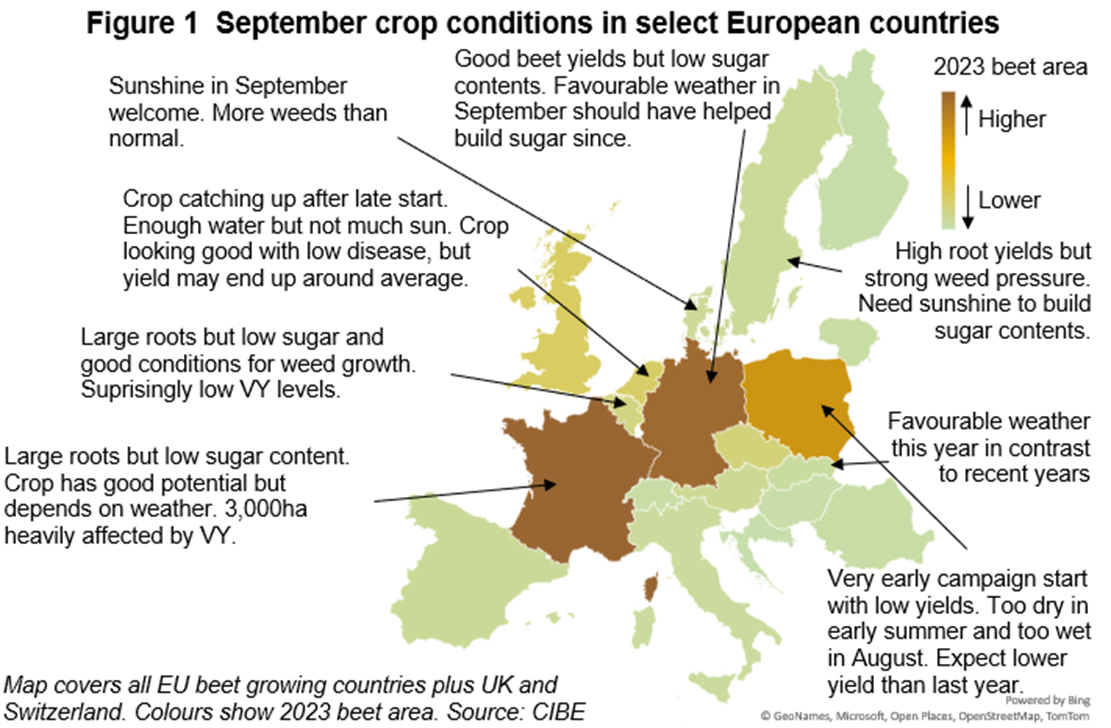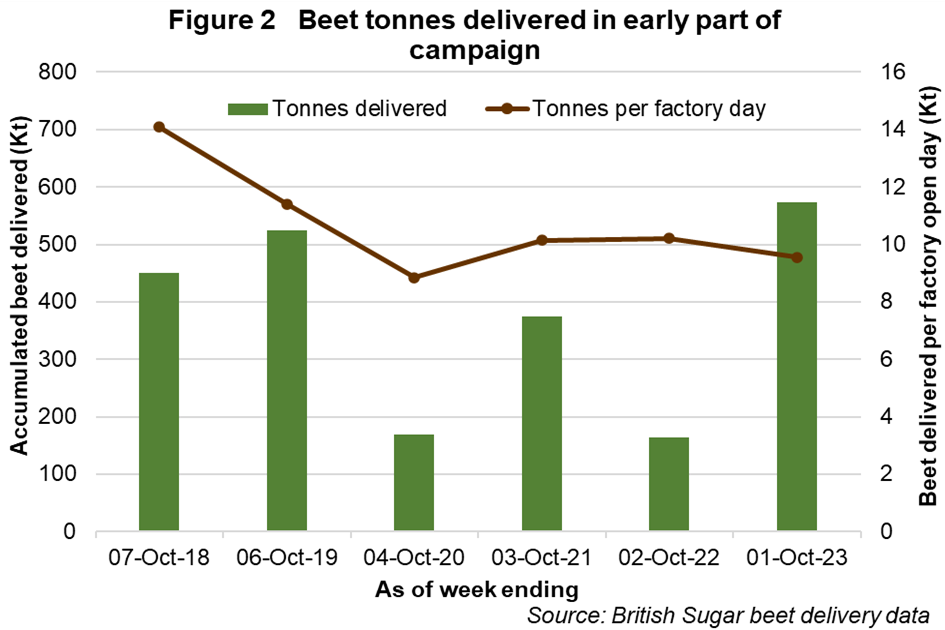Despite the warmest September on record in East Anglia and above average sunshine levels, according to Met Office data, sugar contents have not built to ‘normal’ levels during the month.
The sugar content of UK beet delivered to factories has averaged under 16% in every week of the 2023 campaign to date, marking the lowest sugar content seen in beet at this time of year for at least the last 10 years. This continues the trend of large roots and low sugar contents seen in crop tests pre-campaign.
One theory is that with plants a few weeks less mature than usual (due to the late planting), combined with warm night temperatures, the crop is not yet preparing for winter as much as it normally would at this time of year, and is therefore not building up sugar stores as much as usual. However, if this is correct, the shortening days could limit the crop’s potential to build sugar in the coming months, meaning there is a risk sugar contents remain low through this campaign.
Similar to the UK, beet crops across much of Europe are showing good root yields with low sugar contents. At a crop condition update call last month within CIBE (the European beet growers’ association of which NFU Sugar is a member), there was general optimism for yields being around or slightly above average, but growers in many countries noted that low sugar contents could prevent yields from being substantially above average.
The graphic below summarises the feedback on crop conditions from various countries as of early September, prior to the start of most campaigns.

Beet delivery
Beet deliveries in the campaign to date are higher than in any of the past five campaigns, but daily beet supply has been relatively low. Despite the various early delivery incentives this year, when adjusted for the number of campaign days per factory to date, adjusted tonnes delivered per factory per day have been lower than in most recent years.
Figure 2 below shows the total beet delivered in the early part of the campaign across the last six years, as well as the tonnes delivered per day each factory was open (i.e. two factories open for 10 days would equal 20 factory days).
The lower level of adjusted beet delivered per factory day will partly be a function of the low sugar levels, but could also reflect the appetite and ability of growers to respond to the incentives such as Early Delivery Allowance. While the figure is not far below recent years, it is substantially lower than the delivery rate during the early part of the campaigns prior to 2020, highlighting that the challenge with early beet supply continues for the industry.

A trader's view
NFU Sugar Board appointee and sugar trader Paul Harper shares his thoughts on the current market situation.

NFU Sugar Board appointee Paul Harper
Paul has spent his entire career in commodities and has been in sugar since 1976. He joined C Czarnikow in 1973 working in their London, New York and Singapore offices. Paul has a huge amount of consultancy experience, having consulted for a hedge fund, major bank and a large trade house in sugar during that time.
Having made new contract highs in the middle of September, prices have begun to fall away sharply after a record delivery of 2.8 million tons against the expired October position in the No.11 (raw sugar futures) market.
Current trading levels are around $50 lower in both raw and white markets with long liquidation by some of the funds (i.e. selling of futures positions) aiding the more short-term bearish sentiment.
Statistically very little has changed; Brazil continues to produce sugar with weather continuing to be near perfect, whilst other areas of the world, particularly India and Thailand, continue to suffer. Expectations of lower crops continue in these two important areas and deficit numbers for 2023/24 production/consumption are increasing.
It remains to be seen if the lower prices begin to attract buyers back to the market, especially as it would appear that some demand had definitely been deferred when the market was at higher levels. Should this turn out to be the case, then a sharp turnaround in prices is likely.
Looking forward, the market remains almost wholly reliant on Brazil to supply the demand needs of the world and this potentially could lead to problems should anything occur to disrupt this supply.
There would appear to be little possibility, in the near term, of any major increases in production elsewhere in the world and therefore the deficit situation could continue for a while yet, likely leading to higher prices in the future.
The WABCG view: new record-high based on speculator's views
Taken from the World Association of Beet and Cane Growers’ Flashmarket newsletter on 5 October, by Timothé Masson, Executive Secretary of WABCG and economist for the French beet growers association, CGB.
On 20 September, raw sugar futures went over 27 c/lb: a record high that had not been seen since October 2011.
On the same day, speculators were net-buyers of almost 7.4Mt of sugar, due to fears from India and Thailand.
On 14 September, a representative of the Thai Sugarcane and Sugar Board informed that 70Mt of sugar may be a maximum for the campaign to begin in November. This is a drop of more than 20%, due to El Niño impact, and may result in production of 9Mt. Such a low level had not been seen since 2015.
In India, the news is no better, and the government remained quiet regarding the level of sugar to be exported for the campaign due to open this month.
Even if the ongoing Brazilian campaign is excellent – it will certainly be the second best in history, mainly due to the fact that 50% of the cane will be allocated to sugar, a record high since 2012 that can be explained by the low value of ethanol in Brazil – it did not reassure analysts. Almost all of them now forecast a deficit in 2023-2024 (the fifth consecutive one), which will bring us to what could be historically low stocks at the end of September 2024.
So the level of speculators is quite high. Some may consider it bullish – it can almost double if you consider the level in 2016, but some may consider it bearish – what if their views change in the short term? They are less present for refined sugar, and the white premium is now at $120/t: it is 30% less than last month, but 40% higher than its 5 year-average value.

